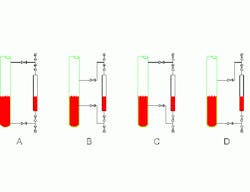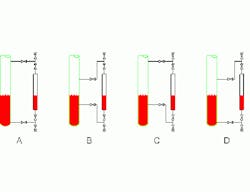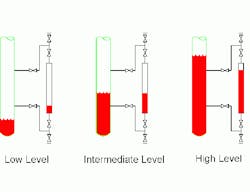Can you trust your sight glasses?
Sight glasses are invaluable for troubleshooting towers and checking instruments. However, don’t let their simplicity fool you into thinking that they are foolproof. As with any instrument, performance depends upon installation, and connection mistakes certainly can compromise sight glass accuracy.
One common problem with sight glasses (and other level instruments) is restricted range. Figure 1 shows four different sight-glass installations. The same type of connections could be made for external wells required for displacement- or float-type level instruments. Only Arrangement A is correct. All of the others suffer from a restricted range defect: B has restricted range on both ends, C on the low level end, and D on the high level end.
Figure 1. Sight gauges are connected in four ways, but only the far left arrangement is correct.
As long as the liquid level remains in the center of the sight glass, between the level taps in the vessel, then the device reads correctly. Problems begin when the level goes outside the range between the taps. Figure 2 shows indicated versus actual levels for restricted-on-both-ends Arrangement B. With a liquid below the lower tap, the seal leg in the instrument connection traps liquid in the sight glass and the sight glass indicates a higher level. With a liquid level above the upper tap, the seal leg in the instrument connection traps vapor in the sight glass and the sight glass shows a lower level. Condensation, vaporization or compression of the vapor space also can change the level in the sight glass, depending upon the system and liquid levels in the vessel.
Figure 2. Range restrictions because of improper installation can cause significant inaccuracy.
I’ve observed all three incorrect level connections at plants. Indeed, such restricted-range sight glasses are common. In fact, they are a classic reason for field troubleshooting. Nothing you can do in the control room can identify incorrect instrument installation. It is essential to actually check the device and make sure its connections are correct.
With restricted range instruments, we are asking them to do what is physically impossible. Safety expert Trevor Kletz, writing about this very problem (“Plant instruments: which ones work and why,” CEP, July 1980, pp. 68-71), summarized the situation perfectly: “One reason why trips and control systems don’t operate properly is that they violate the laws of physics ….”
Using instruments that violate the laws of physics gives improper data to control systems and confuses troubleshooting. Understanding how the instrument works, how it must be connected and how to interpret the readings is critical for profitable operation.


